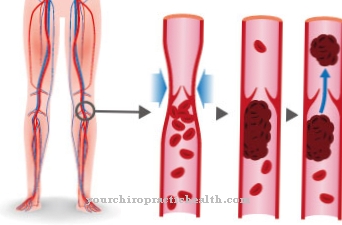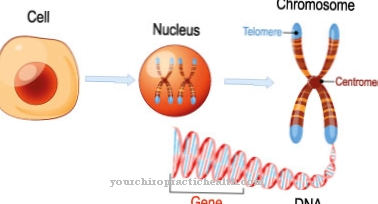Under Perianal thrombosis or Anal thrombosis the formation of very painful lumps in the area of the anus outlet is called. It is uncomfortable, but usually resolves on its own within a few weeks, leaving a fold of skin.
What is perianal thrombosis?

© New Africa - stock.adobe.com
As Perianal thrombosis are blood clots in the anus that appear in the form of nodules and can vary in size depending on the severity of the thrombosis.
Light knots only reach the size of grapes, in severe cases reports have been made of knots that reach the size of plums or pigeon eggs. In some cases, multiple lumps are formed or a lump contains multiple thrombi. The nodes are reddened or appear bluish.
Often, in addition to the formation of lumps, there is also painful water retention, which triggers additional feelings of tension, which further increases the pain caused by the perianal thrombosis. Because of their similarity to hemorrhoids, perianal thromboses are also known as "false hemorrhoids".
causes
The cause of the Perianal thrombosis can be seen in the formation of blood clots in the veins around the anus outlet. What causes these blood clots, however, is the subject of controversy.
In the past, the doctrinal opinion was that long periods of sitting (especially on cold surfaces), high body pressure (for example when coughing, when pressing or lifting heavy weights, in women during childbirth or during their period) and the consumption of alcohol and spicy foods favor the development of a perianal thrombosis.
The existence of larger hemorrhoids could also play a role in the formation of the blood clots. Recent studies suggest that intensive wet cleaning of the anus region and intensive physical activity can also carry a certain risk of developing perianal thrombosis.
Symptoms, ailments & signs
Perianal vein thrombosis is associated with severe pain and usually occurs without warning signs. Unlike hemorrhoids, these are not fine, blood-filled protuberances. Anal vein thromboses have a strongly hardened structure. Their dimensions vary from pea to plum-sized knots.
The appearance is usually characterized by a dark red to bluish color. At first they are noticed by a subtle stinging in the anus area. After a short time this sensation intensifies and the pain intensity increases. Since the direct area of the anus outlet is affected, the sphincter subsequently hits the area that has already been affected. In addition to the actual pain, patients complain of a permanent weeping itch.
Due to the blockage position, the anus does not close flush and secretion escapes from the rectum. Those affected often mistake anal vein thrombosis for haemorrhoids that have occurred. These do not cause any pain worth mentioning in the first stages and remain mobile to a certain extent. In addition, they do not arise spontaneously in just a few minutes, but grow in size slowly and over time.
The hardened knot of a perianal vein thrombosis, on the other hand, is stuck and cannot be pushed back. In addition, it does not tend to bleed. Strong pressure occasionally leads to partial deflation without the knot receding. Those affected report considerable agony during bowel movements.
The passage of hard stool past the pressure-sensitive swelling is considered extremely uncomfortable. Walking and simply sitting on unpadded seats are also very uncomfortable for patients due to the constant friction of the knot.
Diagnosis & course
Perianal thrombosis arise within a very short time, although those affected often do not know the cause themselves. The lumps are noticeable through severe pain and sometimes burning and itching, but are actually harmless and in many cases heal by themselves, which takes several days or even weeks.
If you are unsure about the diagnosis, you should consult your family doctor or a specialized doctor (proctologist or dermatologist). This is particularly indicated if the pain caused by the perianal thrombosis is so severe that the person affected is severely restricted. Even after particularly pronounced thrombi have healed, it can happen that an unsightly skin fold (a so-called skin mask) forms on the affected area, which can be surgically removed at the patient's request.
Complications
In most cases, perianal thrombosis does not result in any particular complications or life-threatening symptoms. The nodes in the anus recede on their own relatively quickly. However, scars or wrinkles can also remain on the skin itself. The patients suffer from very severe pain due to the perianal thrombosis.
This pain is particularly uncomfortable because it is usually no longer possible to sit normally. Defecation is also associated with severe pain. The permanent pain often has a negative effect on the patient's psyche, which can lead to depression or other psychological complaints. Blood clots form in the anus itself and itchy.
As a rule, no direct treatment is necessary for perianal thrombosis. The symptoms disappear relatively quickly and there are no further complications. The pain can be relieved well with the help of pain relievers. Laxatives can also make the stool softer and thus reduce pain. The perianal thrombosis does not affect the life expectancy of the person affected.
When should you go to the doctor?
Although the perianal thrombosis normally heals independently within a few weeks and leads to freedom from symptoms, a doctor's visit should take place as soon as the first irregularities occur. It is important to rule out serious illnesses in the person affected and to create an optimal treatment plan to alleviate the symptoms. If there is pain in the anus, a doctor should be consulted. You should refrain from taking pain medication until you have consulted a doctor, as complications and side effects can occur. In the event of itching, bleeding or changes in the complexion, a doctor should be consulted.
A stabbing sensation in the anus, bleeding and palpable lumps at the exit of the anus should be examined and treated. A doctor should be consulted in the event of internal restlessness, problems with locomotion or discomfort when sitting. A decrease in well-being, swellings and ulcers must be treated by a doctor. If there are open wounds or the formation of pus, special care should be taken. If sterile wound care cannot be guaranteed, the help of a doctor is to be accepted. In severe cases, the affected person is threatened with sepsis. Blood poisoning can be fatal without timely treatment. A feeling of pressure in the anus, changes in libido, or sexual dysfunction should be discussed with a doctor.
Treatment & Therapy
In many cases it is sufficient Perianal thrombosis self-treating, for example by applying creams and ointments that contain anti-inflammatory ingredients (anti-inflammatory drugs).
Oral pain reliever medication like ibuprofen, which is also anti-inflammatory, can also relieve pain. Most people affected find it helpful to make sure that the stool is as soft as possible during this time (for example, by using mild laxatives or a diet with a lot of fluid intake, perhaps dried fruit on an empty stomach and flaxseed consumption).
Sitz baths round off the therapy. In the case of larger lumps or those that are extremely painful, the only option left is to consult a specialist and have the thrombi cut open under local anesthesia, which then pushes the thrombi out. This procedure can be carried out by some general practitioners, but also by dermatologists, surgeons and proctologists. As a rule, healing then takes place quickly and without complications. If skin tags have formed, it is possible to have them surgically removed.
Outlook & forecast
As a rule, a perianal thrombosis heals without complications. After a few days to weeks, the healing process is complete with conservative therapy. Usually, no damage remains and the tissue recedes completely. A spontaneous discharge of the thrombus, which is accompanied by bleeding, may occur. This leads to a sudden freedom from symptoms.
Sometimes perianal folds of skin called anal skin folds form during healing. Due to the thrombi, the skin tissue is overstretched and is then no longer able to regress completely. The skin tags do not cause any discomfort, but can be perceived as annoying by the patient. The skin folds can be removed as a whole under local anesthesia. There are hardly any risks involved in this procedure, but in some circumstances it can lead to impaired wound healing.
With surgical treatment, the elimination of the thrombosis provides immediate pain relief. Scarring can only rarely be seen or felt. Perianal thrombosis tends to recur. In conservatively treated patients, the rate is 15%. With surgical therapy, the likelihood decreases.
prevention
As it is not known exactly what caused the knot formation Perianal thrombosis it is also difficult to consciously prevent this clinical picture. Until further research is carried out, it is therefore advisable to avoid long periods of sitting (on cold surfaces) or to interrupt sedentary activities again and again, to restrict wet cleaning of the anus region or to change anal hygiene practices and to reduce the consumption of spicy foods and alcohol. A conscious relaxation when coughing or lifting or pressing is hardly possible.
Aftercare
Perinanal thrombosis requires good follow-up care, regardless of whether it has resolved spontaneously or has been surgically opened. On the one hand, this is about the healing of a possibly resulting small wound in the anal canal. On the other hand, aftercare is synonymous with prevention in order to prevent the development of a new perianal thrombosis.
Excessive hygiene in the anal area is strongly discouraged. Avoid harsh cleaning and very rough toilet paper. Normal washing with lukewarm water is sufficient, the sensitive area being carefully dabbed dry.
Strong pressure favors the recurrence of a perianal thrombosis and also has an unfavorable effect on any necessary wound healing. It is therefore important to regulate your bowel movements so that they are not too hard. For this it is important to drink enough. Water and herbal teas are ideal. Diet rich in fiber is also recommended. Fruits and vegetables are just as helpful as whole grain products.
If this alone is not enough for effective stool regulation, psyllium husks are a valuable helper. They are available in health food stores, among others, are simply stirred into water and drunk after a short period of soaking. Sufficient drinking is also important here.
Exercise is also important in the follow-up care of perinal anal thrombosis. It promotes digestion and the necessary bowel movements and in this way can avoid pressing.
You can do that yourself
Perianal thrombosis is a symptom that the person affected can have a positive influence on in everyday life through consistent behavior. In the acute phase, the main concern in this context is not to subject the anal vein thrombosis, which is bulging or opened by the doctor, to further irritation. This applies to long periods of sitting as well as to wearing tight trousers. When it comes to hygiene after going to the toilet, rough paper and moist toilet paper should not be used. Strong rubbing is also better replaced by gently dabbing the affected areas on the edge of the anus.
In order to promote the rapid healing of a perianal thrombosis and to prevent further thrombosis in this area, changes in the patient's behavior that are closely related to diet are helpful. Anal vein thrombosis, similar to hemorrhoids, is often caused by pressure caused by strong pressure when defecating. It is therefore important both in the treatment and prevention of perinanal thrombosis that constipation can be avoided.
Patients achieve this by eating a high-fiber diet and drinking a sufficient amount. If this does not work, the stool can be loosened by natural means such as psyllium husks or flaxseed, which are simply dissolved in water or stirred into yogurt and then consumed. Foods that bloat are better to replace with alternatives in the acute phase.

.jpg)
.jpg)

.jpg)

.jpg)




















